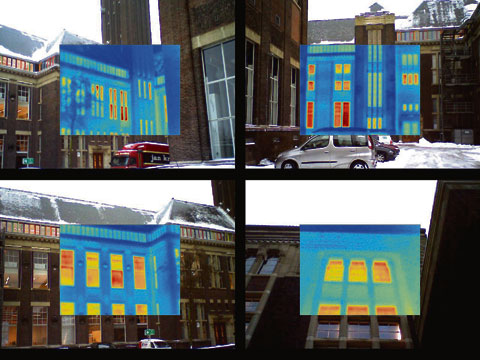Not only the exterior of BK-city is monumental, so too is its heat loss, says Michaelis Prodromou (MSc), whose graduation project focused on BK-city’s sustainable refurbishment.
Last week Michaelis Prodromou was one of the three laureates for the UfD-Cofely Energy Efficiency Awards. He originally came to Delft to pursue his Master’s degree in Building Engineering (Civil Engineering and Geosciences) because of the programme’s environmental aspects. “The Netherlands is a front runner in climate change studies, together with Germany, Denmark and Sweden,” Prodromou says on the telephone from Athens. He now works for the World Wildlife Fund developing an energy efficiency label for apartments.
BK-city is a colossal building on the northern edge of the campus that has served during its long history as a uranium depot and refugee shelter, as well as the TU’s (former) Main Administration office. It was built in the 1920s and is now – as Prodromou puts it – characterised by “its obsolete fabric and outdated building service systems.” Prodromou vividly recalls his first visit to the Architecture faculty, which now houses BK-city. “On the second floor Bachelor’s students were dripping sweat over their drawings while one floor below
people were wearing coats behind their desks.” He was immediately motivated to come up with plans that would both respect the building’s monumental exterior yet at the same time improve the internal climate and energy efficiency. “It can turn into a monument for good environmental practice,” Prodromou says. It should be noted here that poor as its energy efficiency may be, BK-city is not an exception among Dutch educational buildings.
The largest heat leaks are via the large, high windows. But because of their aesthetics they cannot easily be replaced by well-insulated double-glazing. Nor can their steel frames support double-glazed windows. Prodromou therefore proposes to place extra windows behind (on the interior side of) the original ones. In the few places where this not feasible, he proposes to uses thick curtains to provide extra insulation. Apparently similar windows with good thermal properties can be manufactured, but the costs seem to be prohibitive.
The other large thermal leak is the roof of the building, which carries no insulation whatever.
“Simple measures can bring enormous improvements,” says Prodromou. In his thesis he presents three refurbishments strategies named ‘basic but cheap’, ‘ambitious but feasible’ and ‘innovative but risky’. Even the basic renovation plan entails a drastic insulation of walls, floors and attic, reducing draft and improving ventilation.
More advanced ideas feature a heat storage tank in BK-city’s large but inaccessible tower (originally designed as a tank for storing fire-extinguishing water), shading the windows and geothermal heating. Calculations show that energy use can be reduced by between 25 to 70 percent.
Prodromou’s thesis supervisor, Professor Andy van den Dobbelsteen, is working with Professor Wytze Patijn on a follow-up report. Both professors are presently unavailable due to skiing holidays.
Link to thesis in repository:
http://bit.ly/hIuMbY
Naam: Saskia Wagenaar (20, L&R)
Dreamteam: Dare (www.dare.tudelft.nl)
Functie: Commissaris internal affairs
Net als alle ruim honderd teamleden begon Saskia Wagenaar haar raketcarrière bij Dare met een relatief simpele raket. “Om de fijne kneepjes van rakettechnologie te leren.” De bedoeling is om een ei een kilometer de lucht in te schieten en deze weer heelhuids op de grond te krijgen. “Op militaire basis ’t Harde mogen we de raketten afschieten. Bij ons was de parachute echter niet open gegaan en had de raket zich in de grond geboord. Pas na een dag hadden de militairen hem gevonden. Ja, het ei was kapot.” De opdracht is een oefening voor grotere projecten, zoals de Stratos-raket die vorig jaar in Zweden het Europees hoogterecord brak door een hoogte van 12,5 kilometer te bereiken. “Hoewel succesvol, ging ook daar de parachute niet open en moest de raket geborgen. Teamleden zijn in de Zweedse moerassen op expeditie gegaan om te zoeken op de vermoedelijke landingsplaats, eerst zonder succes. Toen ze ’s avonds hout gingen zoeken voor een kampvuur, zagen ze hem. Hij was ingeslagen in een boom, Ach, daar leer je van. De meeste van onze landingen gaan trouwens goed hoor.”



Comments are closed.